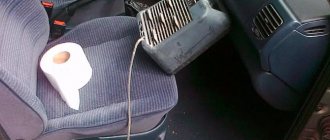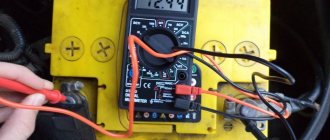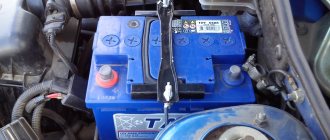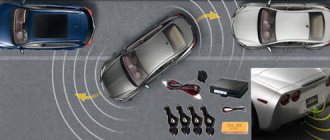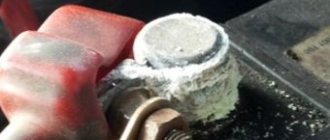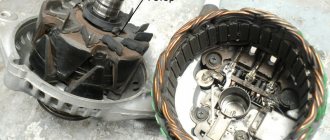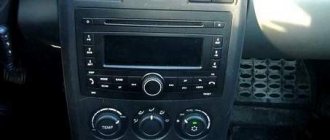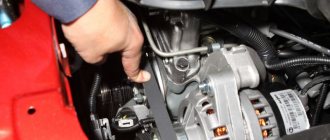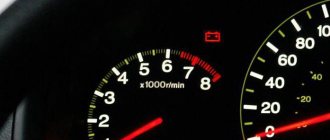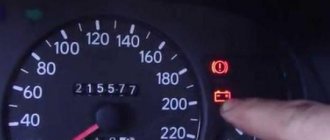Purpose of distilled water
Distilled water is an important component in the liquid of a car battery, ensures its full functionality, maintains the desired density of the electrolyte, which contains 65%. And the percentage of sulfuric acid is only 35%.
Sulfuric acid is a fairly highly concentrated chemical compound that, in its pure form, poses a danger to the battery. To reduce its concentration, purified water is needed. The ratio Н2О/H2SO4 = 65/35 ensures the accumulation of electrical energy at the time of charging the battery, which is subsequently used to start and move the vehicle.
Distilled water (DV) is ordinary water purified from organic compounds (waste products of plants and animals, bacteria, viruses) and inorganic impurities (salts, mineral additives, other substances). It consists of two chemical elements: hydrogen (H) and oxygen (O).
Before you find out how much distilled water to add to the battery, it is important to understand that ordinary water is not suitable for such a procedure. It contains a large number of different impurities (salts, chlorine, lime and others), which contribute to the rapid failure of the car battery. You cannot pour boiled water into the battery, since ordinary boiling does not distill (purify) the liquid in full.
Proper battery maintenance
Currently, the industry mainly produces low-maintenance batteries for cars; they require a minimum of care, however, preventive maintenance must be carried out regularly. To service the battery, you must:
- Remove the battery from the car:
- take it to a warm room;
- clean the housing from dirt and salt deposits (do not turn the housing over);
- clean the terminals from deposits with sandpaper; if they are oxidized, wipe dry with a clean rag;
- let it sit for 10-12 hours (you can do it for a day; it is especially important to let the battery “dead” in winter).
Then you should check the electrolyte level in the jars, add distilled water if necessary, and charge the battery. You can’t do without a charger, just like you can’t do without a hydrometer, and it would also be nice to have a multimeter and a load plug. After the battery has settled, we check the voltage without load with a multimeter; it should be in the range of 12.4-12.7 Volts. When connected to the terminals of the load plug, the voltage should not fall below 9.6 V, the load lasts about 5 seconds.
After adding water to the required level, we check the density with a hydrometer; in those jars where we had to add more, the density will be lower accordingly. Then we place the plugs in their places without tightening them, connect the charger to the terminals, if the battery is in fairly good condition, automatic mode is suitable for charging.
The battery is charged most efficiently at room temperature +20ºC; after charging, it is again necessary to let the battery sit, but 5-7 hours is enough. Then we repeat all the checks again, the most optimal values are:
- voltage without load – 12.7 Volts (up to 13.0 V);
- under load – from 9.6 to 10.4 V;
- density – 1.27-1.28 g/cm³.
For northern regions, the electrolyte density can be set higher (up to a value of 1.31); for southern regions, 1.26 g/cm³ is often sufficient.
Depending on the type of battery, it is recommended to carry out battery maintenance once or twice a year; low-antimony batteries require maintenance more often, approximately once every 3 months. Video: Water or electrolyte, what should I add to the battery?
Related articles:
- TOP 10 best batteries for a car 2018 A car battery is not something you buy for one year. A good battery is not cheap and is purchased for several years (usually from three to eight). Exactly […]
- Caring for battery terminals - methods, materials used A car battery requires care, even if it is a maintenance-free type: dirt and oxides formed on the body during operation negatively affect the condition of the battery […]
- Checking the functionality of the generator without removing it from the car. Failure to charge the battery can have unpleasant consequences: there is not enough energy to power consumers, and the engine stops starting. To understand the cause of the problem, [...]
Why is no electrolyte used?
During the operation of the battery, especially in the summer, the battery heats up, as a result of which the jars may boil. The DW evaporates at this moment. Acid is a non-volatile liquid; accordingly, it remains and the concentration of water decreases. The density of the mixture sometimes increases to 1.4 g/cm 3 . Therefore, in order to bring the electrolyte to normal density, it is necessary to add DV.
If you pour electrolyte, the density will decrease, but not enough.
It is important to remember about salt precipitation and destruction of the plates. Therefore, in order to reduce the density of the liquid to the established norm, only DV is added. This rule must always be remembered!
It is also worth remembering that water is added only to batteries of the type being serviced, which are characterized by maximum evaporation. Maintenance-free batteries are equipped with a molded sealed case; the evaporated liquid does not come out, it precipitates inside the can. In this case, a closed cycle occurs; there is no need to add water.
When is battery refilling required?
Most experts believe that car batteries do not require maintenance. Accordingly, adding water to it is irrelevant, but provided that the battery is used under normal conditions. It is imperative to check the fluid level for motorists who travel long distances in their own cars. In this case, the probability of converting the liquid into a vapor state is greatest. And also the active process of water evaporation is carried out in the event of failure of the relay regulator.
Main indicators of failure of the relay regulator:
- during the operation of the vehicle, the battery becomes very hot;
- drops of electrolyte are observed on the battery body;
- Strong steam comes out of the filler necks.
It is necessary to take into account the design of the battery. In serviced models, much greater evaporation of H2O occurs. Therefore, it is for them that it is worth knowing how much water to add to the battery. In maintenance-free models, evaporation of liquid into the environment is prevented by a sealed cast housing. Such batteries do not require additional maintenance.
How do the properties of electrolyte change in a vehicle battery?
Many professionals consider the question of what to put in the battery to be absolutely incorrect, since the device is classified as a non-repairable element. However, a good battery is far from a cheap pleasure, so the desire of car owners to extend its service life is understandable. To ensure that refilling the battery does not lead to its complete failure, you first need to understand the processes that occur during the operation of the battery during its systematic charging and discharging.
Initially, from the factory, the battery contains an emulsion, which consists of thirty-five percent sulfuric acid, while the remaining sixty-five percent of the volume is distillate - purified water, without impurities. During operation, the device heats up, an electrolysis reaction occurs, and part of the water evaporates under the influence of high temperature and collects as condensate on the inner surface of the unit. If the battery has a completely sealed design and there is no mechanical damage in the case, then when it cools, the steam turns into water and flows back down the walls of the device. If there is damage to the case as a result of operation of the device or due to poor manufacturing quality of the product, the water evaporates from the battery irretrievably. As a result of this process, the liquid in the battery becomes more concentrated, and the density of the acid increases. This is reflected in the voltage output criteria of the device and its performance.
In addition to the natural process of evaporation at operating temperatures, the so-called sulfation reaction occurs in the battery - the deposition of acid salts on the lead strips of the battery. As a result of this process, the electrolyte concentration decreases. Precedents when the density of the electrolyte drops are most often provoked by irregular functioning of the battery as a result of prolonged downtime of the car or incorrect operation of the battery - supplying too much current to the device or serious malfunctions in the vehicle electronics.
Checking the electrolyte level
The presence of electrolyte is checked exclusively in serviced batteries. They are most often equipped with a transparent body, so inspection is carried out visually. For this purpose, special marks are made on the surface corresponding to a certain volume of liquid.
Serviceable batteries with an opaque casing are also available. To determine to what level to add water to the battery in this case, the vehicle owner will need a special transparent tube with a diameter of 0.5 cm.
Fluid level check sequence:
- The battery cover is unscrewed;
- the transparent tube is lowered into the liquid, and it should rest against the bottom of the jar;
- its outer hole is clamped tightly with a finger;
- it is then removed from the battery to determine the electrolyte level.
Such a tube has minimum and maximum divisions. Accordingly, if the accumulated liquid is within these limits, the volume of electrolyte is normal. If the fluid is below the minimum, you need to add DV.
How to add fluid correctly
If the density of the electrolyte in a car battery has increased or the battery does not provide the required voltage, then the reason is evaporation of the active substance. According to the norm, the electrolyte consists of: H2SO4 (sulfuric acid) - 35%; H2O - 65%.
Instructions for adding fluid to the battery:
- The upper surface of the battery is cleaned of dirt and thoroughly wiped, especially near the plugs.
- While charging the battery, sulfuric acid may have splashed out. Therefore, to neutralize it, the neck area must be wiped with a rag soaked in a soda solution.
- Now you need to carefully unscrew the plugs. It is recommended to wear gloves to protect your hands from the electrolyte.
- Using a medical syringe, DV is drawn up and poured into jars where the liquid level has dropped.
- The plugs are screwed in.
- After 2 hours, it is necessary to check compliance with the electrolyte density standards using a special device - a hydrometer. If the indicators are normal, the battery can be charged.
Add liquid only on a horizontal surface, otherwise the level will show the wrong volume. It is also worth considering the fact that the density of the electrolyte differs in different climatic conditions. For example, in Russia:
- in the south of the country - 1.25 g/cm3;
- in the central regions - 1.27 g/cm3;
- in the northern territories - 1.29 g/cm3.
To accurately measure the density of a liquid, the hydrometer must be strictly in a free state, in a vertical position and not in contact with the walls of the container. Having carefully lowered the hydrometer into the liquid, you need to wait until it completely stops oscillating, then take readings on the scale at the point of its intersection with the surface of the electrolyte. This is the density of the liquid.
Using boiled water
It is generally accepted that boiling kills all bacteria and makes the water absolutely clean and safe. But is it possible to simply fill with boiled water if we are talking about a battery? This is a rather interesting question.
When you don’t have a bottle of distillate at hand, the surest solution seems to be to take liquid from the tap, put it on the stove, boil, cool and pour it into the radiator.
To use tap water, it must first be purified. And usually motorists think about boiling. Yes, this treatment removes substances harmful to human health. That is, you can use it for food and drink, but not for electrolyte.
Let's take a closer look at the question of whether it is possible to add plain boiled water to a car battery.
Boiling of a liquid occurs at 100 degrees Celsius. This processing procedure allows you to reduce hardness and form sediment. But the hardness does not drop to zero values. Plus, a large amount of steam is released, which does not take various types of impurities with it. That is, there is a decrease in water volume, but this does not affect the amount of additives.
For clarity, it should be explained how boiled water differs from special distilled water, which is recommended to be poured into the battery. During heat treatment the following processes occur:
- The water is disinfected. From the standpoint of human health, this is good, since drinking water after boiling is safer. But disinfection does not affect the battery in any way.
- The volume of water decreases, and at the same time the concentration of impurities increases. From this point of view, boiling gives even more disadvantages than advantages.
- Salts precipitate. They only affect temporary hardness, but not permanent hardness. The effect is minimal.
- The concentration of salts and minerals remains at the initial level, as before boiling.
Since boiling does not have any effect, many naturally think that special drinking water will be an excellent solution. Another misconception. Drinking water contains a number of beneficial additives, which makes it healthy. But all these components are detrimental to the battery.
Obtaining distillate at home
There are motorists who do not go to the store for DV. They produce it themselves at home. This is mainly the older generation, who lived through times of shortage, and people living in settlements remote from the city, where many products simply do not arrive.
If you want to prepare DV yourself, you should understand that it will not be of high quality, since for this you need to have special expensive equipment - a distiller. But as an alternative, a regular moonshine still without a coil is suitable. The productivity of the DV when using this option will be approximately 1 glass in 3-4 hours.
The formula of distilled water is H2O. A high-quality liquid should not contain foreign impurities. It is impossible to achieve such a result under domestic conditions; a small content of metal salts will still remain.
Recommendations:
- If you urgently need to add water to the battery, you can take it from the tap into a plastic bottle and put it in the freezer for 2-3 hours. You should only use ice that has been melted beforehand. Unfrozen water is drained into the sink. The DV obtained in this way will cause minimal damage to the battery.
- Another way is to collect rainwater in a plastic container, carefully filter it, and then use it for its intended purpose.
Important! The collected water for the battery should not come into contact with iron objects. For example, water running off the metal roof of a house is not suitable for this purpose.
Owners of serviced car batteries need to regularly monitor the level of electrolyte in them and, if necessary, add pure H2O, free of minerals and organic additives. This water is called distilled and is an important component of the battery fluid. Its task is to maintain the chemical composition of the electrolyte at an optimal level, thereby guaranteeing high-quality battery operation.
Before you find out how to properly pour purified liquid into the battery, it is important to remember that it is prohibited to use tap or boiled water for this purpose. They contain a lot of foreign impurities (iron, calcium, magnesium, chlorine), which are deposited on the metal plates of the battery during charging. This “scale” leads to a decrease in battery capacity and destruction of its plates. This changes the density of the electrolyte in the battery.
What happens if you fill in the wrong liquid?
If you use ordinary untreated water, deposits can quickly form on the electrodes. Because of them, the plates may collapse.
Poor quality water leads to deterioration of electrical conductivity. The resulting sediment subsequently leads to rapid battery discharge. The result may be its complete failure.
If you add an inappropriate component, it is possible:
- accelerating the process of battery loss of water included in the electrolyte;
- increasing the resistance of battery plates;
- increasing the density of the electrolyte itself.
Even a single use of undistilled water can lead to sedimentation. As a result, the system will be short circuited.
Where can I get distilled water?
Car owners can buy deeply purified water in a five-liter bottle or other container at a hardware store, supermarket (in the household appliances department), pharmacy or at a gas station in the auto cosmetics department; these outlets are supplied by trusted suppliers. The largest manufacturer and supplier of distilled water is. You can order and buy distilled water on this page. You can also get it in normal home conditions, using one of the traditional methods of cleansing.
The first method is evaporation. For it you will need a large saucepan that closes tightly with a lid, a glass container and a metal grid. A wire rack is placed in the pan and then filled halfway with plain water. The glass container is placed on the grill so that its neck rises above the water. The pan is tightly closed with a lid and put on gas. Ice is placed on top of it. The water boils, condenses on the cooled lid and is collected in a glass container.
The second method is freezing. To do this, running water is poured into a plastic bottle and placed in the freezer. After half the liquid turns into ice, the unfrozen water is drained from the bottle and the remaining ice is melted. This is the distillate.
And the easiest way is to collect rainwater, which is a natural distillate. True, in large cities it has too high a percentage of acidic impurities, which makes it unsuitable for use in a battery.
Correctly pour distilled water into the car battery
The service life of the car battery and the serviceability of the car’s electrical network depend on how correctly we pour the distillate into the car’s battery. By maintaining the sequence of actions, we thereby extend the life of the battery.
1. Place the battery strictly horizontally. Otherwise, you will either overfill the water or not add it due to the fact that there will be different levels of liquid in the jars.
2. Wipe the surface of the battery around the edges of the plugs to remove any dirt.
3. Dip a rag in the soda solution and wipe the necks of the jars with it to neutralize the sulfuric acid that has accumulated there during the charging process.
4. Unscrew the caps, trying to prevent electrolyte from getting on your hands (it is better to wear gloves).
5. Fill a small rubber bulb with purified water and carefully pour it into each jar.
6. Inspect the electrolyte level in the jars - the battery fluid should be 1 cm above the top edge of the plates.
7. Simply remove excess liquid with a pear in the required volume.
8. Screw on the caps.
9. Charge the battery no earlier than after 3-4 hours.
Just add water: how to revive a dead battery
Serviced or not?
The electrolyte of lead batteries consists of two components - sulfuric acid and water.
Water, which evaporates over time, is to blame for the decrease in electrolyte levels. As a result, some of the plates are not immersed in the electrolyte, and the battery loses capacity. If in summer this effect can be ignored painlessly, in winter it will certainly give you a frosty morning pig... It is customary for car owners to divide batteries into “maintenance” and “non-maintenance” according to the type of caps on banks. If the plugs are present and can be unscrewed with a coin, it means it is “serviceable”: you need to monitor the electrolyte level and add water if necessary. If there are no traffic jams, it’s the other way around.
Articles / Practice Light a cigarette - throw away the battery: myths and truth about batteries in winter Winter has arrived, and with it traditional battery problems. Both advanced car enthusiasts and lazy drivers encounter them: cars with open hoods are waiting to “light up”... 109971 10 12 12/22/2016
- In fact, “maintenance-free” lies primarily in the fact that the battery is made with calcium additives in the lead electrodes instead of the good old antimony, which has been used for decades, says Alexander Kazunin, head of the battery laboratory of the Research Institute of Automotive Electronics and Electrical Equipment.
- “Calcium” batteries have a very low rate of electrolysis of water, which almost does not evaporate from the electrolyte under normal operating conditions. And therefore, they often lack plugs to control the electrolyte level. However, you need to understand that with the advent of “calcium” batteries, the problem of electrolyte boiling away did not completely disappear. “Antimy” batteries, which are prone to a drop in the electrolyte level, are still produced and sold, and “calcium” batteries can easily require monitoring and topping up if the car is driven intensively in the summer in the city cycle or, say, the voltage regulator in the generator is faulty.
Calcium can be applied only to the negative electrodes of the battery or to all electrodes. Batteries in which all electrodes are doped with calcium are called “calcium-calcium” (Ca/Ca). True, the price to pay for the lack of maintenance of the electrolyte level is increased sensitivity to deep discharge. A “calcium” battery, once set to “zero”, as a rule, does not last long...
About water
Often, even in truly maintenance-free batteries, there are still plugs, but they are not separate, but attached to a common plastic plate, which is covered with a branded sticker on top. There are no obvious signs on these plugs that they can be opened. But this can be done, and often necessary. Because the electrolyte level can drop in almost any type of battery.
Leveling a low electrolyte level in a battery is easy and inexpensive. It is enough to purchase a bottle of distilled water from a car store and add it using a syringe or bulb to each battery jar, the number of which is six for a car with a 12-volt electrical system. Looking into the jars with a flashlight, you can see the plas, which is a level mark. If it is not there, water is added until the plates are completely covered. After this, it is highly advisable not to load the battery with the starter, but to recharge it.
Articles / Practice We charge a dead battery in 10 minutes: experiment Kolesa.ru Many of those who are not shy about getting into the “guts” of their car with tools know in practice about a very curious, useful, but at the same time strange and poorly explained... 237100 9 62 04/18/2016
This procedure is simple and accessible to any car owner. The only bottleneck in this story is the purchase of distilled water. Typically, the “distillation” packaged in 1.5-liter bottles is produced by companies like “Horns and Hooves,” and it is not so easy to find water produced by a well-known brand of automotive chemicals on sale. And in view of the low retail and even lower purchase price of distilled water, manufacturers have a serious temptation to reduce costs as much as possible and start dispensing tap water under the guise of distillation for batteries... Moreover, a deceived buyer is unlikely to make a claim: the battery is from ordinary water, will certainly die, but this will not happen instantly.
Here is a typical review of low-quality distilled water from one of the UAZBUKI forum members:
“Once I had an unopened bottle of this water lying in my trunk. She probably lay there for four months. And somehow I decided to add it to the cooling system. I opened the bottle and it smelled like rotten stuff - at least run away. What swamp did they get it from..."
TDS meter
You can check the quality of purchased distilled water using different methods. The most correct way of checking available at home is to use a specialized device called a TDS meter. Chinese online stores are full of them, they are not too expensive, and the accuracy is quite sufficient for our needs. The TDS meter looks like a pencil with a display and measures the level of total mineralization (salt content) of water in “ppm” units - the number of particles of dissolved salts per million particles of an aqueous solution.
We measure tap water - 215 ppm. We measure distilled water from a car store - a bottle from one manufacturer shows 8 ppm, a second – 7 ppm, and a third, the one that says “double purification”, shows 0 ppm!
Respect to the last manufacturer, of course! The product is really high quality. But even if the ppm of distillation is not zero, there is no need to worry. A small number is within acceptable limits. In the end, almost any Soviet textbook on automotive operating materials, as a last resort, allowed the use of melted snow water for the electrolyte (not from city snowdrifts, of course), the ppm of which is usually 10-20.
1 / 4
2 / 4
3 / 4
4 / 4
Ohmmeter
Many sources suggest checking the quality of distilled water with a multimeter in ohmmeter mode. In other words, simply by measuring its resistance. Often there are even numbers: if the water resistance is more than 30 kilo-ohms, this means the water is suitable for the battery.
At first glance, it looks reasonable: a multimeter, unlike a TDS meter, is found at home or in the garage much more often than the latter. And the TDS meter calculates the number of ppm indirectly, precisely through measuring the water resistance.
But there is a fundamental difference: a TDS meter measures resistance on alternating current, and an ohmmeter measures resistance on direct current. And electrochemical processes that begin in water when direct current is passed introduce very large errors. And when we add to them the completely random geometric dimensions of the ohmmeter’s measuring electrodes, and the distance between them, taken by eye, the parameters begin to jump chaotically, changing tens of times. So you shouldn’t use a multimeter to assess the quality of the distillate.
Evaporation
The next method is visual. It is unlikely to give a clear assessment of the quality of the “distillation”, but at least it will allow you to identify outright fraud when, under the guise of demineralized water, they slip you tap water.
For this test we need a clean piece of glass. We drop two drops of water on it next to each other: what we consider to be distilled, and tap water for clarity. Then we wait for the water to evaporate, which can be accelerated by heating the glass on the lighter. After evaporation, distilled water leaves virtually no salt stains, the stain simply disappears. If obvious salt “circles” are noticeable, the water is most likely from the tap...
In the photo on the left there is a salt stain from tap water, on the right nothing is visible - a drop of distilled water has evaporated there.
220 volt
And finally, one more way. Severe Chelyabinsk - checking water resistance on an alternating current electrical network of 220 volts. As it becomes clear, it is based on the fact that ordinary water conducts electric current, while distilled water practically does not. This is also a conditional test that does not give results in digital form, but is quite suitable for everyday use, and most importantly, it is visual. The procedure is quite simple, but requires some caution when handling exposed live wires!
We assemble a simple circuit from an electrical cord with a plug and a socket for a 220-volt incandescent lamp. Approximately in the middle of the double cord, cut one of the wires and strip the ends. Now the cut ends serve only as a breaker. We screw in the lamp, insert the plug into the socket for testing - the lamp burns at full intensity. Now we take out the plug, cut one of the wires of the pair, strip both ends to a length of about a centimeter each and lower these ends into a glass of test water. Re-insert the plug into the socket. The lamp will not burn on distilled water, but on tap water its filament will glow dimly, dimly, at less than a quarter of the incandescence.
Well, now that it is clear which water is truly distilled and which is not, the only thing left to do is add the “correct” water to the battery. And in the same way as we described above. And enjoy the good battery performance.
Survey
What do you do if the battery does not spin well?
Your voice
Total votes:
How much distilled water should be added?
The batteries of new models, made of translucent plastic, are quite easy to add water to. On their body there is a scale with the manufacturer’s recommended liquid level, which must be adhered to. The situation is more complicated with older type batteries. Here are some tips to help you cope with the task. If your battery has a small tongue below the neck of the cans (metal or plastic), then water should be added until the electrolyte level rises 5 mm above it. If there is no tongue, then you need to add distilled water until the electrolyte level rises 1 cm above the top of the plates.
And a few more important points: do not add water to the car's autonomous power supply if you have just turned off the engine. The battery must sit for several hours before it can be opened. In the same way, you cannot immediately turn on the internal combustion engine after adding distilled water to the battery. The battery must sit for at least a few hours, otherwise it may boil.
An excellent alternative to distillate is deionized water. It is purer than distilled water, more precisely 100 times more pure, and can also be used for filling into batteries.
Distilled water for batteries
The battery is an integral part of almost any modern device or car. The battery, like all components of the car, requires care and compliance with recommendations during operation - one of the rules that must be followed is monitoring the level of distilled water in the battery.
It is required for the normal passage of all chemical processes occurring in the battery. When the level drops, you can fill the battery with distilled water yourself. How to do it yourself? How much should I add? How to track the level?
How much water should be added
With modern batteries it is easier to figure out how much DV to add to the system. Their body is often made of transparent plastic, on which the liquid volume scale is broken. You just need to visually monitor its level in the system. It should not be less or more than the permissible norm.
We recommend: Car battery capacity and choice of battery for a car
Recommendations on how to add distilled water to a battery of a different design are as follows:
- Some battery models have a plastic (metal) “tongue” slightly below the neck of the can. It is necessary to fill the liquid 0.5 cm above it.
- If there are no marks in the jar, add water 1.5 cm above the lead plates.
- If it is impossible to visually determine the presence of electrolyte in the battery, then it is recommended to use a specialized glass tube with a scale.
It is important to correctly top up the electrolyte so that the density of the electrolyte meets the established standards. At higher concentrations, hydrochloric acid will destroy lead plates.
If it is deficient, you can defrost a car battery at significant sub-zero temperatures.
How to fill
Serviced
Adding a little or pouring distilled water into the battery (being serviced) is not a problem, and it is possible to carry out the process yourself:
- You need to purchase distilled water (best at a pharmacy).
- The plugs are unscrewed so that the electrolyte and plates are visible - if the level of the mixture is below the plates, then it is necessary to fill in water with a syringe until the plates are closed (the level of electrolyte and water should exceed the plates by 1-1.5 cm).
- After adding, you need to charge the battery.
Maintenance-free
Is it possible to add distilled water to a maintenance-free battery? The answer is clear - it’s possible, but it’s more difficult to do than with the type of battery being serviced (the process is not provided by the manufacturer).
First of all, it should be noted that it is necessary to add water to a maintenance-free type battery much less frequently. This is due to the fact that batteries of this type are well sealed, and “ring technology” is used inside, which reduces evaporation to a minimum. The battery life without unnecessary manipulation is about 4-5 years.
Pouring process:
Adding distilled water to the battery
- It is necessary to determine the electrolyte level - to do this, shake the battery and determine the approximate level by sounds. When the feeling suggests that the level is normal, sulfation of the plates may have occurred and there is no point in adding water.
- It is necessary to determine the level of the plates - if the battery is not transparent, then you will have to determine it “by eye”; in other batteries you can illuminate it with a flashlight or buy batteries in a transparent case.
- An indentation is made from the plates by a maximum of 2 cm upwards, it is marked, and a hole is made with a drill (2-3 mm).
- Fill a syringe with distilled water and fill it until water begins to pour out of the hole made.
- The battery is shifted to the other side, and the holes made are sealed with a very ordinary soldering iron.
- Place it on charge and charge to full level.
The process is complex, and there are many inaccurate steps, but do not forget - the manufacturer does not provide for adding water to a maintenance-free battery!
Recommendations
- The surface on which the process takes place must be flat! For what? So that the mixture level is not distorted;
Distilled water for batteries
The process of pouring distilled water into the battery can be seen in the video.
What kind of fluid is in the battery?
Before talking about the liquid that is in the battery, let us clarify that this article is about serviceable batteries. If the battery has a different design and the manufacturer does not provide the ability to control the level and top up fluids in the battery, then this is not possible.
Of course, if necessary, you can convert a maintenance-free battery into a serviceable one. But in this case, you need to understand that you can cause irreparable harm to the battery, after which all that remains is to dispose of it.
You also need to understand that a special gel can be used as an electrolyte. These are so-called gel batteries. The manufacturer of such batteries also does not provide for adding fluid.
Thus, let us determine that in our case we are talking only about serviceable batteries. They use a solution of sulfuric acid and water as an electrolyte. This ratio is 3:7 (30% sulfuric acid to 70% distilled water).
You can learn more about the processes occurring in the battery, the composition of the electrolyte and methods of its preparation by reading the article “what acid is poured into the battery.”
Volume
How much distilled water should I add to the battery? What level is acceptable? It is necessary to top up until the plates disappear and are no longer visible. Translating the values into numbers, the amount of water depends on the total capacity of the battery, so you need to focus on hiding the plates with electrolyte by 1.5-2 cm. It is at this level that the required electrolyte density of 1.27 g/cm 3 is achieved.
Important: if, when adding water, the level is exceeded, the density will decrease, and there will be a possibility of the battery “freezing” in winter. When the level is exceeded, you can pump out the water using the syringe that was used to add it.
As a result, we can say that adding water to serviced batteries is an immediate necessity. The situation with maintenance-free batteries is different - it depends only on the wishes of the car owner. But in any case, you must remember that adding water is a temporary measure! After some time, it will still become unusable, and you will have to buy a new one.
